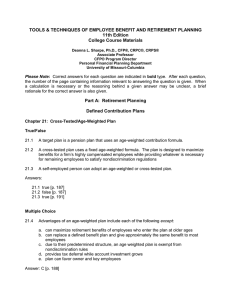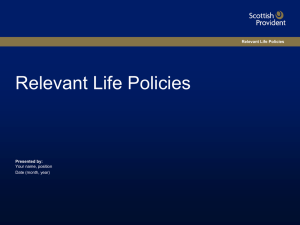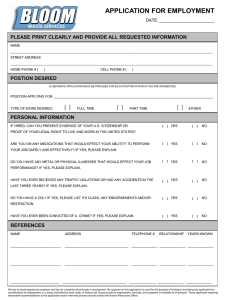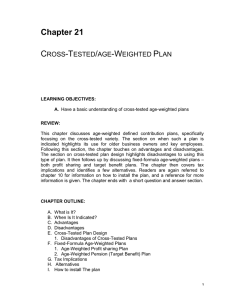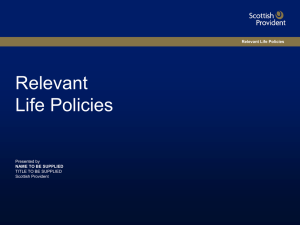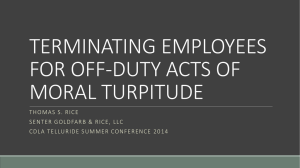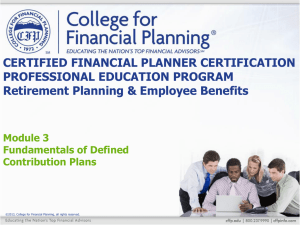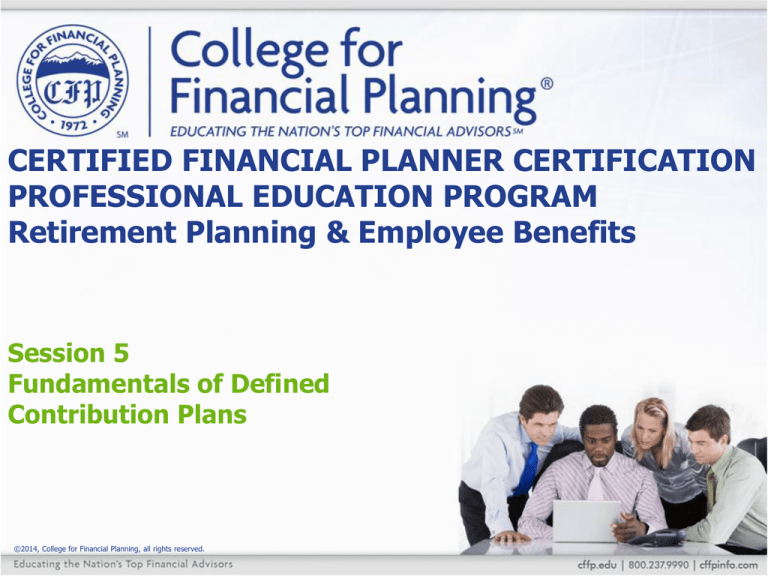
CERTIFIED FINANCIAL PLANNER CERTIFICATION
PROFESSIONAL EDUCATION PROGRAM
Retirement Planning & Employee Benefits
Session 5
Fundamentals of Defined
Contribution Plans
©2014, College for Financial Planning, all rights reserved.
Session Details
Module
3
Chapter(s) 1
LOs
3-1
Describe the basic characteristics of defined
contribution plans.
3-2
Describe the basic characteristics of money
purchase plans.
3-3
Describe the basic characteristics of target
benefit plans.
3-4
Describe the basic characteristics of profit
sharing plans
5-2
Qualified & Nonqualified Plans
Qualified Plans
Nonqualified Plans
Pension Plans
Profit Sharing
Plans (DC)
Tax-Advantaged
Plans
Other Nonqualified
Plans
Defined Benefit (DB)
Profit Sharing
Traditional IRA
Section 457 Plans
Cash Balance (DB)
Thrift Plan
Roth IRA
Stock Bonus
SIMPLE IRA
ISO
Money Purchase (DC)
ESOP (LESOP)
SEP
ESPP
Target Benefit (DC)
Age-Weighted
(SARSEP)
NQSO
403(b) (TSA)
Deferred
Compensation Plans
Cross-Tested
(Comparability)
401(k) Plan
SIMPLE 401(k)
5-3
Profit Sharing & Pension Plans
Qualified Plans
Profit Sharing
Plans
Pension Plans
Money Purchase
Plans
Defined Benefit
Plans
Age-weighted MP
Plans or Target
Plans
Cash Balance
Plans
5-4
Annual Addition Limits
• Annual additions are comprised of
•
o employer contributions
o employee contributions
o forfeitures
IRC Section 415(c) limit on “annual additions”
is the lesser of
o 100% of compensation, or
o $52,000 (2014)
5-5
Contribution Limits
• Employer deduction limit:
•
•
25% of payroll (does not
include employee
deferral amounts)
Combined employee and
employer contribution
limit: $52,000 (2014) or
100% of compensation
Maximum includible
compensation:
$260,000 (2014)
5-6
Pension Plans & Profit Sharing Plans
Mandatory funding?
Employer stock
limitation?
Survivor annuities?
In-service
withdrawals
allowed?
Pension Plans
Profit Sharing
Yes
No
Yes, no more
than 10%
Yes
No, unless age
62 or older if
plan allows
No, up to 100% can
be in employer stock
No
Yes, after two years if
the plan allows
5-7
Profit Sharing Plans
Basic Provisions
• 25% employer deduction limit
• Employer contributions usually are discretionary, but must be
“substantial and recurring”
• Forfeitures usually are reallocated to remaining participants’
accounts
Advantages
Employer
No fixed annual contribution required
may motivate employees if based on
profits
Younger participants benefit from
many years of tax-deferred
Participant
contributions, compounding earnings,
and forfeiture reallocations
Disadvantages
Plan may benefit younger participants
when the goal is to benefit older owner
Employer is not required to contribute
annually
5-8
Defined Contribution Retirement Benefits
Limits on
Employer
Contribution
Limits on
Employee
Deferrals
Allocation of
Employer’s
Contributions
Administrative
Costs/Burden
Target
Benefit
25% deduction
limit—subject to
minimum funding
standard
Not available
Age weighted
Actuary first year
Money
Purchase
25% deduction
limit—subject to
minimum funding
standard
Not available
Fixed
contributions,
can be integrated
with Social
Security
Relatively low
Profit
Sharing
25% deduction
limit
401(k)—
(indexed)
$17,500 plus
catch-up if
eligible
Plan formula may
use salary or
service; can
be age weighted
or include
integration
with Social
Security
Relatively low —
employer
contributions must be
“substantial and
recurring,” but
employer has flexibility
with annual
contributions
Type of
Plan
5-9
Practice Problem 1
Match each item in the left-hand column with the
appropriate item in the right-hand column
Characteristics of Employer
Contributions
A. Mandatory, uniform percentage of pay
B. Mandatory, age-weighted allocation
C. Cashless
D. Requires a gateway contribution
E. “Substantial and recurring”
Retirement Plans
_____Profit sharing plan
_____Cross-tested
_____Money purchase plan
_____Stock bonus plan
_____Target benefit plan
5-10
Multiple Choice Question 2
Which one of the following is not a
characteristic of a target benefit plan?
a. The retirement benefit is not certain;
investment risk is borne by the participant.
b. Annual additions are limited to the lesser of
100% of compensation or $52,000 in 2014.
c. Forfeitures may be applied to reduce the
employer’s contribution, or they may be
reallocated to remaining participants.
d. The plan requires annual actuarial
determination.
5-11
Multiple Choice Question 3
Which of the following plans are subject to a
25% limit on deductible employer contributions?
I. money purchase plans
II. profit sharing plans
III.target benefit plans
IV.tandem (paired) plans
a. I and IV only
b. II and III only
c. I, III, and IV only
d. I, II, III, and IV
5-12
Multiple Choice Question 4
Which of the following statements are correct
descriptions of qualified plans?
I. A target benefit plan is basically an ageweighted money purchase plan.
II. A target benefit plan is a defined benefit plan.
III.A money purchase plan is a pension plan.
IV. A profit sharing plan is a flexible contribution
plan.
a. I and IV only
b. II and IV only
c. I, III, and IV only
d. II, III, and IV only
5-13
Multiple Choice Question 5
Which of the following are characteristics of an age-weighted profit
sharing plan?
I. An age-weighted allocation formula permits contributions to favor
older employees rather than younger employees because the
younger employees have more time to accumulate contributions
and earnings in their accounts.
II. An age-weighted allocation formula permits contributions to
individual accounts to exceed the Section 415 limitations.
III. If an age-weighted plan becomes top heavy, the vesting schedule
would be limited to either a three-year cliff or six-year graded
schedule; the plan also must provide a minimum contribution of
3% of pay to non-key employees.
IV. An employer that uses an age-weighted allocation formula
becomes subject to the minimum funding standards.
a. I and III only
b. II and III only
c. I, II, and III only
d. I, III, and IV only
5-14
Multiple Choice Question 6
Which one of the following objectives for
establishing a profit sharing plan would be best
met through use of an age-weighted profit
sharing plan?
a. using the plan to motivate all employees
b. believing that it is more important to
motivate employees than it is to retain them
c. maximizing contributions for older employees
d. seeking to provide rank-and-file employees
with a solid basis for retirement income
5-15
CERTIFIED FINANCIAL PLANNER CERTIFICATION
PROFESSIONAL EDUCATION PROGRAM
Retirement Planning & Employee Benefits
Session 5
End of Slides
©2014, College for Financial Planning, all rights reserved.


